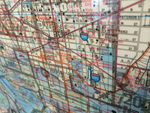Main Streets
The main west-to-east artery of interest to visitors runs across the top of Tian'an Men Square, past the Tian'an Men (Gate of Heavenly Peace) itself. It changes names several times, but is most importantly Xi Chang'an Jie to the west of the square, Dong Chang'an Jie to the east, then Jianguo Men Nei Dajie until it crosses the Second Ring Road, when it becomes Jianguo Men Wai Dajie. Compass points such as xi (west) and dong (east) turn up very frequently in street names, as do words such as men (gate), nei (inside), and wai (outside). Metro Line 1 runs under this route, passing several major hotels and shopping areas. The Xi Dan Bei Dajie and Wangfujing Dajie shopping streets run north from this route. The Second Ring Road runs around the combined outer perimeter of the old city walls they replaced, still showing the bulge of the wider Chinese City to the south and, depending on the time of day, usually provides a quicker route around the city center than going though it. Farther out and quicker still, the Third Ring Road, which links with the airport expressway and routes to the Summer Palace, is the site of several major long-distance bus stations, numerous upmarket joint-venture hotels, and important restaurants. Beware the taxi driver who suggests using the Fourth or Fifth ring roads. Speeds on these routes are higher, but the kilometer count for getting round the city will also be significantly greater, and so will the cost.
Finding an Address
Maps of Beijing are rarely accurate -- the cartographers don't seem to feel it necessary to do more than sketch the main roads -- and the smashing of new routes across and around the city is so rapid they can't keep up. Although some claim to issue half a dozen editions a year, the presence of zui xin or "newest" on the map cover is only an indication that the characters zui xin have been put on the cover. Bilingual maps, or maps with Romanized Chinese, tend to be less accurate to start with, and are printed less often. Regardless of this, always buy a map, available from vendors at all arrival points and at all bookstores, for around ¥5. The staff at your hotel can mark where you are and where you want to go, and you can compare the street-name characters with those on the road signs so you can keep track of your route. There's no question of really getting lost, and you can always flag down a cab and show the driver the characters for where you want to go. Street numbers are given in this book: Odd numbers indicate the north or west side of the street, while an even-numbered residence will be on the south or east side, but otherwise no one uses them. Navigation is by street name and landmark.
Note: This information was accurate when it was published, but can change without notice. Please be sure to confirm all rates and details directly with the companies in question before planning your trip.








